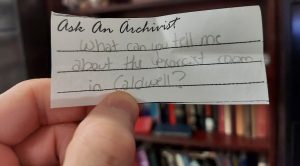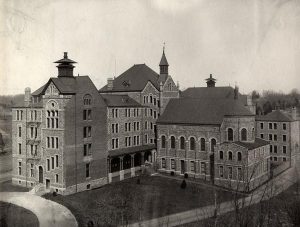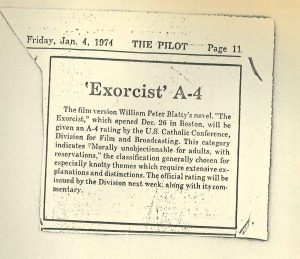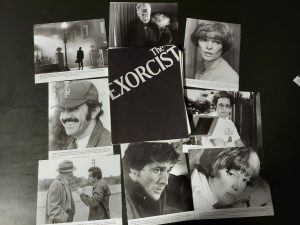
“What can you tell me about the exorcism room in Caldwell?”
So reads one of the most common questions that Special Collections receives during this time of year. In fact, when I first started as an employee in the archives, I was cautioned that this would likely be one of the most common inquiries I would receive each fall. While the question comes in many flavors – what ghost stories exist, what is the exorcism room, and is there a secret exorcist book locked up in the archives – the theme of a hidden, spooky past underlies them all. So, for those brave enough to join us, let us explore this past further. But reader beware, you are in for a scare.
For the uninitiated, let us start by laying out the general outline of the exorcism room story. While there are numerous versions of the tale, it typically revolves around a series of failed exorcisms that occurred in a fifth floor room, located in the attic of Caldwell Hall. Among the numerous versions of the story one involves a former Confederate officer who was denied priestly services for his past military actions, and thus haunts the Hall as a result. Another version links to the 1949 case of Roland Doe, the DC-area exorcism that inspired the novel and film The Exorcist (more on that later). Sometimes a cursed journal or book, detailing rites or an unsuccessful exorcism, is located in the room. Those who encounter the book are beset by a spectral priest, often leading to their falling out a Caldwell window (usually with only a broken ankle as the end result). And, finally, there is often a single name associated with the room – Rev. William Fogarty.

While the other tales lack written evidence, Fr. Fogarty’s case is well-documented. A priest-student at the then-new Catholic University, Fogarty was a resident of Caldwell Hall. In June 1896, Fogarty suffered a fatal accident, falling from a fourth floor window in Caldwell. Reportedly, Fogarty arose in the night and, to cool himself during the hot summer night, decided to get some fresh air out of a window. He lost his balance and fell to the roof of the chapel below. The sound of the fall woke some of his fellow residents, and they came to his aid. Despite some claims in retellings of the accident, Fogarty was not found dead, but instead would succumb to his injuries later that same night at Providence Hospital. While the Washington Post reports that there were no visible injuries, it was believed he may have suffered head trauma. It was a tragedy that hit the small campus community hard.
This tragic tale continued to be passed down by generations of CatholicU students until the present day. My research, however, never found the tale linked with exorcisms for nearly the first century of its retelling. In fact, the first written account of a campus exorcism story appears nearly a century after Fogarty’s passing in the late 1970s. This leads us to our second source for the story – William Friedkin’s 1973 horror classic, The Exorcist.

Whether you like the film or not, there is no denying its cultural impact since it first premiered in December 1973. Based on William Blattley’s bestselling 1971 novel of the same name, the movie recounts a story of a young girl possessed by a demon and a Jesuit priest struggling with his own faith. Not only did its initial release generate terrified responses from its audiences, but it sparked a controversy over the film industry’s rating system. The United States Catholic Conference (USCC) – predecessor to today’s USCCB – had a film review operation at the time, called the Office of Film and Broadcasting (OFB). The OFB, being no stranger to horror films, likewise got caught in the whirlwind of debate over the film’s release. Despite claims today, the USCC was not opposed to the film, and they gave it an A-IV rating, meaning that it was “morally unobjectionable for adults, with reservations”. While this did not mean they endorsed the film, the consensus of American clerics was mixed on the film. Some saw it as “strong propaganda for Christ, the Jesuits, and the Catholic Church” while others viewed it as an overly-exaggerated horror film and nothing more.
According to the OFB records, the studio and director was involved with Catholic authorities, ranging from Georgetown University, the Archdiocese of Washington, and theologians. Although not a filming location, Catholic University still had several indirect roles in the movie…
Jason Miller, who played the role of Father Damien Karras, was a Pulitzer Prize and Tony Award-winning playwright and a CatholicU alumnus of the Speech and Drama program. The Tower even reports on his plays premiering on campus while he was in town, filming for The Exorcist. In addition, legendary actress Mercedes McCambridge, who voiced the demon Pazuzu in the film, was also in town from 1972-73. As an artist-in-residence with the Speech and Drama program, she taught stage and radio acting to students alongside Fr. Gilbert Hartke. In fact, this period of McCambridge’s residency is the source of another campus legend!

Whereas the Tower and other student publications prior to the 1970s hinted at ghosts in dorms or in the library, after The Exorcist hit theaters, tales of exorcism slowly began to proliferate in student publications. But contrary to what you may believe, the first written account was not placed in Caldwell, but in the very building where I am drafting this blog…
The 1979 Cardinal Yearbook reports talk about a secret room in the Mullen Library, housing an “Exorcist Collection”. These books are claimed to be associated with unsuccessful exorcisms in the DC area, and they are kept locked away in a secure Rare Books room. Why else would students not be allowed easy access to such books, unless there was some supernatural mischief afoot?
Prior to the late 1960s, much of the Mullen Library collection resided in unsecure rooms. Collections such as the Clementine Library or the Irish History collection often had open doors at all hours of the day, even when staff was not present. While access is the main goal of libraries, special collection materials were particularly ripe for mistreatment and theft during the early twentieth century. As a result, libraries in the post-war period began to move more towards putting their rare materials in secure rooms and requiring appointments. This approach to the collections may have been novel at the time, and coupled with the legacy of Friedkin’s film, attained a nefarious meaning.

But the story did not end there. By the late 1980s, the Tower reports the first written mention of a Caldwell exorcism room, ribbing freshmen who believed in it. But by the 2000s, when access to the attic of Caldwell was restricted out of safety concerns from the perilous attic floor, accounts of the room became more frequent in student publications.
While tours are known to happen from time-to-time in the space – and are often decorated to match an expected eerie vibe – the space is not safe to enter without a dedicated guide. We do not encourage folks to venture on their own, as the Caldwell attic remains a perilous and fragile space. Instead swap stories and learn more about the history and legends of the campus.

If you wish to dispel this humble archivist of his account above, I am always happy to hear more stories of campus ghosts and ghouls, especially if there are accounts of the exorcism room that escaped our records. It is often difficult to document the word-of-mouth nature of campus folklore, so we must rely on the written record. That record is silent on the topic of campus exorcisms until 1979, with reports mostly picking up in the 2000s, so we lead from there. Please share if you have any new information!
But then again, I could be part of the secret guild of librarians sworn to protect the exorcism book and its forbidden secrets, so I leave it up to you to decide…
Contact the us if you would like to learn more about campus lore/history or if you want to check out some of our spooky rare books: lib-archives@cua.edu

One thought on “The Archivist’s Nook: The Legend of the Exorcism Room”